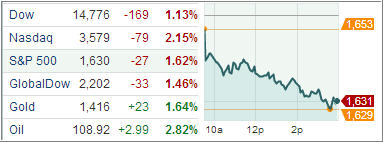Major Index ETFs suffered the worst day since June slumping in a broad decline as geopolitical concerns over a possible US-led military response against Syria worsened, overshadowing data showing an unexpected improvement in Consumer Confidence, a rise in housing prices, and a jump in regional manufacturing activity.
The S&P 500 closed below its 100-day moving average, a sign of weak short-term momentum. The day’s fall extends recent losses on uncertainty over when the U.S. Federal Reserve will start to slow its monetary policies. Retreats of the major averages sent the CBOE Volatility Index to its highest level since early July as investors scrambled to buy protection.
Crude oil and gold prices moved solidly higher in the midst of the geopolitical unease, and Treasuries gained ground. Concerns over possible supply interruptions helped crude oil end at its highest level in more than a year, climbing 2.8% to $108.84 per barrel. While most cyclical sectors ended behind the broader market, the energy space outperformed with a loss of 0.6% as the surge in crude contributed to the sector’s strength.
The drop in yields helped rate-sensitive telecom services and utilities, which ended little changed. However, other sectors were not as fortunate as six groups lost more than 1.0%, and two of those six fell more than 2.0% a piece.
Two top-weighted sectors, financials and technology, led to the downside with respective losses of 2.4% and 2.0%. The weakness in technology was notable as the sector had provided leadership in recent days. Elsewhere, industrials also finished among the laggards as transportation-related companies underperformed.
Today’s economic data showed consumer confidence unexpectedly increased in August. The Conference Board’s Consumer Confidence Index edged up to 81.5, contrary to expectations for a decline of 1.2 points to 79.1. It is historically consistent with trending economic growth.
This is supposed to give us assurance that the consumer side of the economy remains stable and should continue to add to growth in 2H.
Meanwhile, existing home prices rose in June, despite higher mortgage rates, according to S&P Case-Shiller. On a y/y basis, both indexes are up about 12%, the most since spring 2006. The pace of growth, however, has leveled over the past three months, suggesting higher mortgage rates are taking some of the steam out of the housing demand.
Our Trend Tracking Indexes (TTIs) joined the major index ETFs in this pullback with the Domestic TTI closing at +1.15% while the International TTI ended the day at +3.26%.
Contact Ulli
